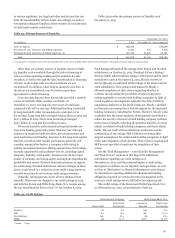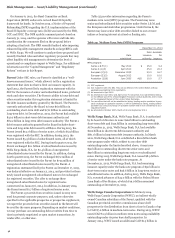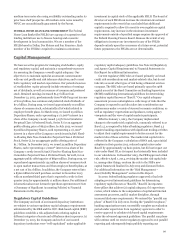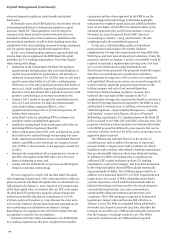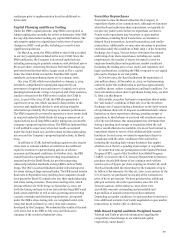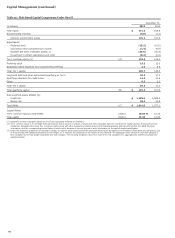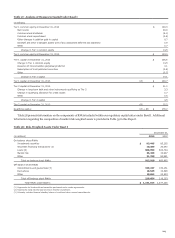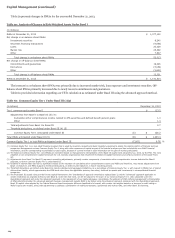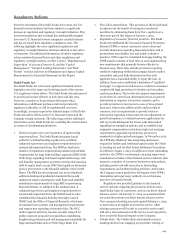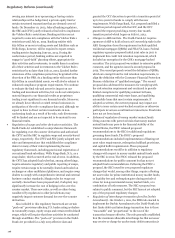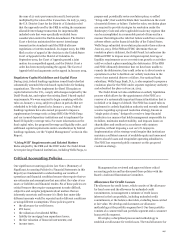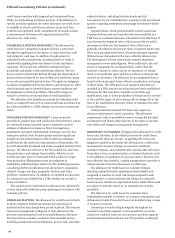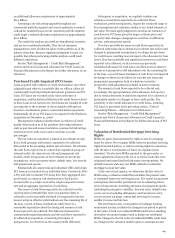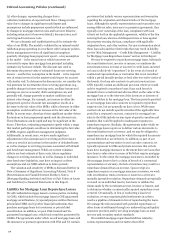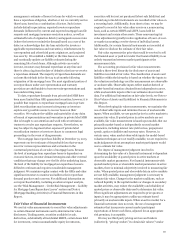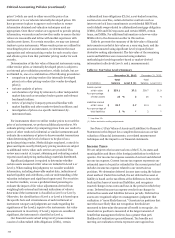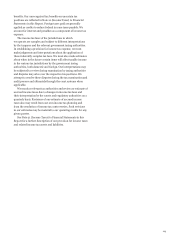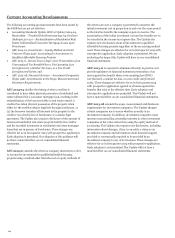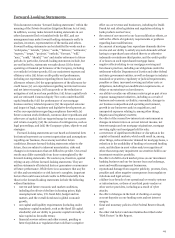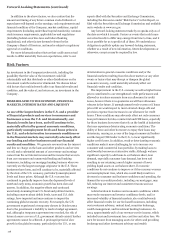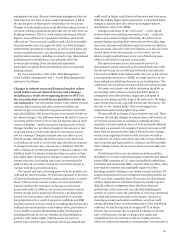Wells Fargo 2013 Annual Report Download - page 109
Download and view the complete annual report
Please find page 109 of the 2013 Wells Fargo annual report below. You can navigate through the pages in the report by either clicking on the pages listed below, or by using the keyword search tool below to find specific information within the annual report.
the sum of 21 cents per transaction and 5 basis points
multiplied by the value of the transaction. On July 31, 2013,
the U.S. District Court for the District of Columbia ruled
that the approach used by the FRB in setting the maximum
allowable interchange transaction fee impermissibly
included costs that were specifically excluded from
consideration under the Durbin Amendment. The District
Court’s decision maintained the current interchange
transaction fee standards until the FRB drafts new
regulations or interim standards. In August 2013, the FRB
filed a notice of appeal of the decision to the United States
Court of Appeals for the District of Columbia. In
September 2013, the Court of Appeals granted a joint
motion for an expedited appeal, and the District Court’s
order has been stayed pending the appeal. The Court of
Appeals held oral arguments on the appeal in January 2014.
Regulatory Capital Guidelines and Capital Plans
During 2013, federal banking regulators issued final rules that
substantially amended the risk-based capital rules for banking
organizations. The rules implement the Basel III regulatory
capital reforms in the U.S., comply with changes required by the
Dodd-Frank Act, and replace the existing Basel I-based capital
requirements. We were required to begin complying with the
rules on January 1, 2014, subject to phase-in periods that are
scheduled to be fully phased in by January 1, 2022. Federal
banking regulators have also issued proposals to impose a
supplementary leverage ratio on large BHCs like Wells Fargo
and our insured depository institutions and to implement the
Basel III liquidity coverage ratio. For more information on the
final capital rules, the proposed leverage and liquidity rules, and
additional capital requirements under consideration by federal
banking regulators, see the “Capital Management” section in this
Report.
“Living Will” Requirements and Related Matters
Rules adopted by the FRB and the FDIC under the Dodd-Frank
Act require large financial institutions, including Wells Fargo, to
prepare and periodically revise resolution plans, so called
“living-wills”, that would facilitate their resolution in the event
of material distress or failure. Under the rules, resolution plans
are required to provide strategies for resolution under the
Bankruptcy Code and other applicable insolvency regimes that
can be accomplished in a reasonable period of time and in a
manner that mitigates the risk that failure would have serious
adverse effects on the financial stability of the United States.
Wells Fargo submitted its resolution plan under these rules on
June 29, 2013. If the FRB and FDIC determine that our
resolution plan is deficient, the Dodd-Frank Act authorizes the
FRB and FDIC to impose more stringent capital, leverage or
liquidity requirements on us or restrict our growth or activities
until we submit a plan remedying the deficiencies. If the FRB
and FDIC ultimately determine that we have been unable to
remedy the deficiencies, they could order us to divest assets or
operations in order to facilitate our orderly resolution in the
event of our material distress or failure. Our national bank
subsidiary, Wells Fargo Bank, N.A., is also required to prepare a
resolution plan for the FDIC under separate regulatory authority
and submitted the plan on June 29, 2013.
The Dodd-Frank Act also establishes an orderly liquidation
process which allows for the appointment of the FDIC as a
receiver of a systemically important financial institution that is
in default or in danger of default. The FDIC has issued rules to
implement its orderly liquidation authority and recently released
a notice regarding a proposed resolution strategy, known as
“single point of entry,” designed to resolve a large financial
institution in a manner that holds management responsible for
its failure, maintains market stability, and imposes losses on
shareholders and creditors in accordance with statutory
priorities, without imposing a cost on U.S. taxpayers.
Implementation of the strategy would require that institutions
maintain a sufficient amount of available equity and unsecured
debt to absorb losses and recapitalize operating subsidiaries.
The FDIC has requested public comment on this proposed
resolution strategy.
Critical Accounting Policies
Our significant accounting policies (see Note 1 (Summary of
Significant Accounting Policies) to Financial Statements in this
Report) are fundamental to understanding our results of
operations and financial condition because they require that we
use estimates and assumptions that may affect the value of our
assets or liabilities and financial results. Six of these policies are
critical because they require management to make difficult,
subjective and complex judgments about matters that are
inherently uncertain and because it is likely that materially
different amounts would be reported under different conditions
or using different assumptions. These policies govern:
x
x
x
x
x
x
the allowance for credit losses;
PCI loans;
the valuation of residential MSRs;
liability for mortgage loan repurchase losses;
the fair valuation of financial instruments; and
income taxes.
Management has reviewed and approved these critical
accounting policies and has discussed these policies with the
Board’s Audit and Examination Committee.
Allowance for Credit Losses
The allowance for credit losses, which consists of the allowance
for loan losses and the allowance for unfunded credit
commitments, is management’s estimate of credit losses
inherent in the loan portfolio, including unfunded credit
commitments, at the balance sheet date, excluding loans carried
at fair value. We develop and document our allowance
methodology at the portfolio segment level. Our loan portfolio
consists of a commercial loan portfolio segment and a consumer
loan portfolio segment.
We employ a disciplined process and methodology to
establish our allowance for credit losses. The total allowance for
107


